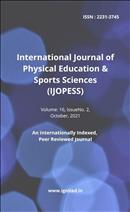The Application of physics in sports
Main Article Content
Authors
Abstract
The research set out to shed light on some fundamentals of physics and how they can beapplied to athletics. Biomechanics refers to the study of how physical laws can be applied to athletics. Youcan break the term biomechanics” down into its constituent parts by separating the prefix bio- and theword mechanics,” from which the term derives its name. The term biomechanics was coined becauseof the field's focus on mechanical principles as they apply to biological processes. Given its origins in theword mechanics, it's safe to assume that biomechanics is concerned with the study of force and itsconsequences. According to this definition, biomechanics is the study of how mechanical forces affectbiological systems. As Herbert Hatze put it in 1974, Biomechanics is the study of the structure andfunction of biological systems by means of the methods of mechanics, so this is essentially what thefield entails. Improvements in performance, technique, equipment, injury prevention, and rehabilitationare all targets of sport and exercise biomechanics.
Downloads
Download data is not yet available.
Article Details
Section
Articles
References
- Adair, R. K. (2002). The physics of baseball. New York: Harper Perennial.
- Cross, R. (2011). Physics of baseball and softball. New York: Springer.
- Denny, M. (2011). Gliding for gold. The physics of winter sports. Baltimore: The Johns Hopkins Univ. Press.
- Fontanella, J. J. (2006). The physics of basketball. Baltimore: Johns Hopkins Univ. Press.
- Guttersrud, O. (2008). Mathematical modelling in upper secondary education [Dissertation thesis]. Oslo: Univ. Oslo ISSN, 1501–7710.
- Haake, S. (2012). Material advantage. Physics World, July 2012, 26–26.
- Kimball, J. (2010). The physics of sailing. Boca Raton: CRC Press.
- Mathelitsch, L. & Thaller, S. (2012). Olympische Rekorde. Physik in unserer Zeit, 43(4), 186–189.
- Spathopoulos, V. (2013). An introduction to the physics of sports. CreateSpace Independent Pub.
- Thaller, S. (2003). Hochsprung auf dem Mond. Physik in unserer Zeit, 34(9), 87–89.
- Nara, K., (2017). A study of physical fitness between basketball and football players of Haryana. International Journal of Physiology, Nutrition and Physical Education, (1), 01-04.
- Poonam. (2018). A comparative study on selected physical fitness components between kabaddi and kho-kho players. International Journal of Yoga, Physiotherapy and Physical Education, 3 (1), 154-156. Online available at: http://www.sportsjournal.in/archives/2018/vol3/issue1/3-1-59
- Ruhil, M., (2016). A Comparison of Selected Physical Fitness Parameters and Physiological Parameters between Individual Sports Athletes and Team Sports Athletes. International Educational E-Journal, 5(4), 1-10.
- Sahrawat,M., et al. (2016). Comparison of self-concept, stress and social adjustment between sports women and non-sports women. International Journal of Management and Applied Science, 2(6) 10-13.
- Zhang, H., (2013). Research on Emotional Adjustment Effect of Sports Game on the Primary and Middle School Students. International Workshop on Computer Science in Sports, 3(2), 99-102.
- Cappella, E., & Weinstein, R., (2006). The prevention of social aggression among girls. Social Development, 15(3), 434-462. https://doi.org/10.1111/j.1467- 9507.2006.00350.x
- Filaire, E., et al. (2009). Psychophysiological stress in tennis players during the first single match of a tournament. Psychoneuroendocrinology. 34(1), 150-7.
- Gill, M., & Kaur, R., (2010).Comparative Study of Physical Fitness Components of Rural and Urban Female Students of Punjabi University, Patiala. Journal The Anthropologist, 12(1), 17-21.
- Kumar, A., & Malik, S., C., (2011). Performance Analysis of a Computer System with Imperfect Fault Detection of Hardware, Precedia Computer Science, 45(2), 602-610.
- Sood (2012) A comparative study of motor fitness components between inter- collegiate volleyball and basketball players of Punjabi University Patiala. International Educational E-Journal, 6 (3),78-80.
- Ioana, O., (2013). A Study on the Relationship Between Sports and Aggression, Sports Science, 22 (1-2), 33-48.
- Singh, H., (2015). Comparative Study on Selected Physical Fitness and Physiological Variables Between Volleyball and Handball Players. European Journal of Physical Education and Sport,10(4),206-211
- Bashir, M., Kumari, S., & Kumar, S. (2016). Aggression and self-concept among sports men and non-sports men: A comparative study, 5(2),1-8.
- Kumar, S., & Singh,N., (2017). A Comparative Study On 'Adjustment' and 'selfConcept' of the College Students. International Journal of Technical Research and Applications, 5 (4), 23-26.
- Mohan KB, .et, al. (2013) “Effects of dietry lipid, Carnation and exercise on lipid profile in rat.blood, liver and muscle.” Mysore 57011, India.
- Wioleta Dudzinska, et.al. (2015). The athletes heart syndrome study related to food 13.5-69% trained athlete’s performance disease to practice 80- 90%. 3509-575
- Christopher Bismarck Eke.et.al. (2018)Effects of weight loss on serum lipoprotein (a) concentrations in an obese population clin, chem, 37:1191-1195.

